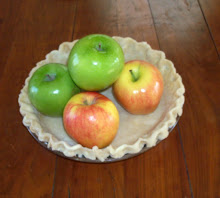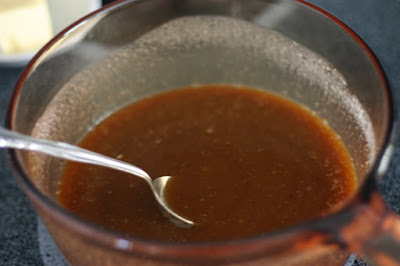For many years, my Thanksgiving duty has been pecan pie. I'd settled into a rut, using the same recipe for bourbon pecan pie, which was awesome in the sense that it had bourbon! and pecans! but otherwise wasn't that great. The final straw was last year's cooking disaster.
The bourbon pecan pie recipe included pastry, which had previously given lackluster results, so I substituted a pastry recipe from one of my cooking idols, a source that can do no wrong. The crust rolled out beautifully. I poured in the filling and was just giddy as I slid it into the oven. I went into the next room to relax. 20 minutes later I was interrupted by...smoke!
You see, that trusted pastry recipe had a lot of butter. The pie had a low baking temperature. Which meant that the butter literally melted right out of the crust and dripped to the bottom of the oven, where it produced great clouds of smoke. At no point was there any danger of fire, but the end result was "smoked" pecan pie on a rancid gummy crust, a major oven cleaning project, and a lingering bitter smoky smell in the house.
All of which is to explain why I was in the market for a new pecan pie recipe. I combined my trusted pastry recipe and "old fashioned" (aka no corn syrup) pecan pie filling. No bourbon in the pie, but plenty in the whipped cream. A winner through and through.
Ingredients
(Recipe from Cook's Country)
- Pie
- Single crust for 9" pie (I used my favorite pie crust recipe, and you should use yours)
- 1 ½ cups toasted and chopped pecans
- 6 large egg yolks
- 1 cup maple syrup
- 1 cup packed light brown sugar
- ½ cup heavy cream
- 1 tablespoon molasses
- 4 tablespoons unsalted butter
- Salt
- Bourbon Whipped Cream
- ½ cup heavy cream, chilled
- 1 tablespoons bourbon
- 1 tablespoon light brown sugar
- ¼ teaspoon vanilla extract
As usual, I made the pastry the night before and rolled it out the day of baking. Once the dough is rolled out, put in back in the frig for at least 30 minutes. Click here for a pie roll out tutorial.
When the pecan are ready, they will smell so wonderful that you will be tempted to forget all about the pie and just eat the pecans then and there.
Chop the pecans very lightly. You don't want a lot of whole pecans left, but you don't want "pecan dust" either.
Now for the tedious part. Separate the eggs and mix the yolks. Note that you're left with 6 egg whites, a subtle hint that you'll be eating a few egg white omelets to make up for the pecan pie.
Heat a pan on medium and add the cream, brown sugar, syrup, and molasses. Stir for a few minutes.
The idea is to get it warm and blended, and then take it off the heat.
Put the pecans in the pie shell.
Add the butter to the still-warm filling and whisk to melt.
Blend in the egg yolks.
Pour the filling over the pecans. Put the pie in the oven and immediately lower the oven temperature to 350°. Place a baking sheet in the rack underneath the pie.
This is what the bottom of your oven will look like if you don't use the baking sheet. No where near as bad as last year's ol' smokey incident, but I have another oven cleaning project on my hands.
Bake for 45-60 minutes. The center will still be jiggly when you take it out of the oven. And by the way, be careful when you take it out of the oven. This missing crust pieces? That's where my big ol' oven mitts crushed it on the way out. Let it cool for one hour, and then put it in the fridge until fully cool.
Just before serving, make whipped cream.
Whip the cream in a chilled bowl.
Let it form soft peaks and then add the bourbon, vanilla, and brown sugar. (NOTE: the original recipe said to combine all ingredients before whipping. Liars! I tried this and the cream didn't whip. Luckily I had just enough time to make an emergency trip to the store to get more cream.)
Pie, meet cream.






















































